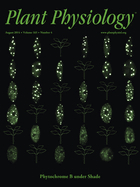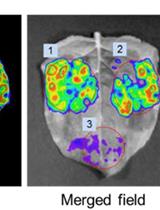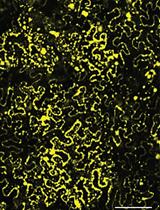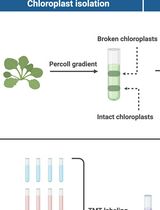- EN - English
- CN - 中文
Phosphatase Protection Assay: 14-3-3 Binding Protects the Phosphate group of RSG from λ Protein Phosphatase
磷酸酶保护试验:14-3-3结合保护λ蛋白磷酸酶中的RSG磷酸根
发布: 2015年02月05日第5卷第3期 DOI: 10.21769/BioProtoc.1395 浏览次数: 10643
评审: Tie LiuAnonymous reviewer(s)
Abstract
14-3-3 proteins regulate diverse cellular processes in eukaryotes by binding to phospho-serine or threonine of target proteins. One of the physiological functions of 14-3-3 is to bind and protect phosphate groups of the target proteins against phosphatases. REPRESSION OF SHOOT GROWTH (RSG) is a tobacco (Nicotiana tabacum) transcription factor that is involved in the feedback regulation of biosynthetic genes of plant hormone gibberellin. 14-3-3 binds to phospho-Ser-114 in RSG. Ca2+-dependent protein kinase NtCDPK1 was identified as a kinase that phosphorylates Ser-114 of RSG. Our recent study revealed that NtCDPK1 forms a heterotrimer with RSG and 14-3-3 and that 14-3-3 was transferred from NtCDPK1 to phosphorylated RSG (Ito et al., 2014). In the course of the study, we found that 14-3-3 protects the phosphate group of RSG from λ protein phosphatase in vitro. Here, we describe a protocol for in vitro phosphatase protection assay. To detect the phosphorylation state of proteins, we used Phos-tag SDS-PAGE and autoradiography. This protocol can be adapted for the examinations whether the phosphoprotein-binding proteins protect the phosphate group of target proteins from phosphatases although protein kinases may be required for the phosphorylation of target proteins.
Keywords: Phosphatase (磷酸酶)Materials and Reagents
- 20 mM ATP
- [γ-32P] ATP (5,000 Ci/mmol, 10 mCi/ml) (Institute of Isotopes, catalog number: SBP-401 )
- λ protein phosphatase (New England Biolabs, catalog number: P0753S )
- Amylose resin (New England Biolabs, catalog number: E8021 )
- COSMOGEL His-Accept (Nacalai Tesque, catalog number: 08368-12 )
- Glutathione Sepharose 4B (GE Healthcare, catalog number: 17-0756-01 )
- Phos-tag acrylamide (Wako Pure Chemical Industries, catalog number: 304-93521 )
- Wide-view prestained protein size marker III (Wako Pure Chemical Industries, catalog number: 230-02461 )
- His.tag monoclonal antibody (Merck Millipore, catalog number: 70796-4CN )
- Phenylmethanesulfonyl fluoride (PMSF)
- Dialysis buffer (see Recipes)
- 10x phosphorylation buffer (see Recipes)
- Binding buffer (see Recipes)
- Dephosphorylation buffer (see Recipes)
- 2x SDS protein sample buffer (see Recipes)
Equipment
- 1.5 ml microcentrifuge tubes
- Refrigerated microcentrifuge
- Microtube rotator
- GELoader tips 0.5-20 µl (Eppendorf, catalog number: 0030 001.222 )
- Heat block
- SDS-PAGE apparatus
- Gel transfer apparatus
- Power supply
- Shaker
- Phosphorimager
- Chemiluminescence imaging system
Procedure
文章信息
版权信息
© 2015 The Authors; exclusive licensee Bio-protocol LLC.
如何引用
Readers should cite both the Bio-protocol article and the original research article where this protocol was used:
- Ito, T. and Takahashi, Y. (2015). Phosphatase Protection Assay: 14-3-3 Binding Protects the Phosphate group of RSG from λ Protein Phosphatase. Bio-protocol 5(3): e1395. DOI: 10.21769/BioProtoc.1395.
- Ito, T., Nakata, M., Fukazawa, J., Ishida, S. and Takahashi, Y. (2014). Scaffold function of Ca2+-dependent protein kinase: Tobacco Ca2+-DEPENDENT PROTEIN KINASE1 transfers 14-3-3 to the substrate REPRESSION OF SHOOT GROWTH after phosphorylation. Plant Physiol 165(4): 1737-1750.
分类
植物科学 > 植物生物化学 > 蛋白质 > 相互作用
生物化学 > 蛋白质 > 相互作用 > 蛋白质-蛋白质相互作用
生物化学 > 蛋白质 > 活性
您对这篇实验方法有问题吗?
在此处发布您的问题,我们将邀请本文作者来回答。同时,我们会将您的问题发布到Bio-protocol Exchange,以便寻求社区成员的帮助。
Share
Bluesky
X
Copy link














